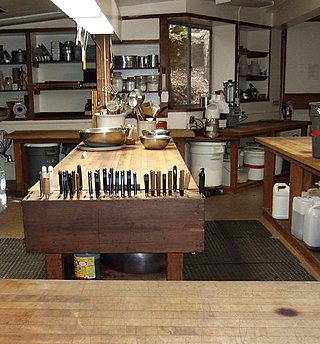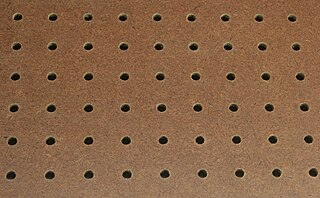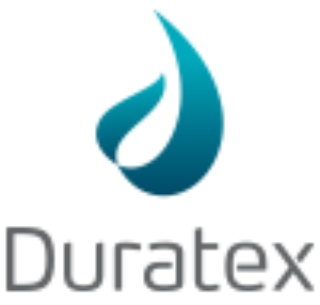


Hardboard, also called high-density fiberboard (HDF), [1] is a type of fiberboard, which is an engineered wood product. [2] It is used in furniture and in the construction industry.



Hardboard, also called high-density fiberboard (HDF), [1] is a type of fiberboard, which is an engineered wood product. [2] It is used in furniture and in the construction industry.
Hardboard is similar to particle board and medium-density fiberboard, but is denser and much stronger and harder because it is made out of exploded wood fibers that have been highly compressed. [3] Consequently, the density of hardboard is 500 kg/m3 (31 lb/cu ft) or more [4] and is usually about 800–1,040 kg/m3 (50–65 lb/cu ft). [5] It differs from particle board and medium-density fiberboard in that the bonding of the wood fibers requires no additional adhesive, the original lignin in the wood fibers sufficing to bond the hardboard together, [6] although resin is often added.
Hardboard is produced in either a wet or dry process. The wet process, known as the Mason Method, [7] leaves one smooth side and one textured side, while the dry processed hardboard is smooth on both sides. Masonite is produced using the wet process only.
A product resembling hardboard was first made in England in 1898 by hot pressing waste paper. [8] In the 1900s, fiber building board of relatively low density was manufactured in Canada. At around the same time the first commercially produced MDF was developed in 1966 in Deposit, New York, United States. In the early 1920s, improved methods of compressing wet wood pulp at high temperatures resulted in a higher density product. [8]
Unlike solid wood, hardboard is very homogeneous with no grain. A wood veneer can be glued onto it to give the appearance of solid wood. Other overlays include Formica, laminated papers, ceramics,[ citation needed ] and vinyl. It has many uses, such as a substrate. It is used in construction, flooring, furniture, home appliances, automobiles and cabinetry, and is popular among acrylic and oil painters as a painting surface due to its economical price (though it must be coated with gesso or canvas before use). [9] Hardboard has often been used as the surface material in clipboards, especially older models. It is also used as the final layer in many skateboard ramps and the half-pipe. Hardboard is also used extensively in theatrical environments, often used as the final painted surface of a stage and on walking surfaces of constructed scenery. Hardboard is also used to make puzzles, game boards, and other toys.
Tempered hardboard is a hardboard that has been coated with a thin film of linseed oil and then baked; this gives it more water resistance, impact resistance, hardness, rigidity and tensile strength. An earlier tempering process involved immersing the board in linseed oil or tung oil until it was 5 to 6 percent saturated, and heating to 170 °C (338 °F). [10] Tempered hardboard is used in construction siding.

Perforated hardboard, also called pegboard, is tempered hardboard that has a uniform array of 1⁄8-or-1⁄4-inch (3.2 or 6.4 mm) holes in it, into which tool-hanging hooks or store fixtures can be placed.
Hardboard has become less popular in the construction industry in recent years due to new environmental targets [11] to procure more sustainable temporary protection materials.

Oil painting is a painting method involving the procedure of painting with pigments with a medium of drying oil as the binder. It has been the most common technique for artistic painting on canvas, wood panel or copper for several centuries, spreading from Europe to the rest of the world. The advantages of oil for painting images include "greater flexibility, richer and denser colour, the use of layers, and a wider range from light to dark". But the process is slower, especially when one layer of paint needs to be allowed to dry before another is applied.

Plywood is a composite material manufactured from thin layers, or "plies", of wood veneer that are glued together with adjacent layers, having both glued with each other at right angle or at 90 degrees angle. It is an engineered wood from the family of manufactured boards, which include medium-density fibreboard (MDF), oriented strand board (OSB), and particle board.
Flooring is the general term for a permanent covering of a floor, or for the work of installing such a floor covering. Floor covering is a term to generically describe any finish material applied over a floor structure to provide a walking surface. Both terms are used interchangeably but floor covering refers more to loose-laid materials.

Engineered wood, also called mass timber, composite wood, human-made wood, or manufactured board, includes a range of derivative wood products which are manufactured by binding or fixing the strands, particles, fibres, or veneers or boards of wood, together with adhesives, or other methods of fixation to form composite material. The panels vary in size but can range upwards of 64 by 8 feet and in the case of cross-laminated timber (CLT) can be of any thickness from a few inches to 16 inches (410 mm) or more. These products are engineered to precise design specifications, which are tested to meet national or international standards and provide uniformity and predictability in their structural performance. Engineered wood products are used in a variety of applications, from home construction to commercial buildings to industrial products. The products can be used for joists and beams that replace steel in many building projects. The term mass timber describes a group of building materials that can replace concrete assemblies.

Oriented strand board (OSB) is a type of engineered wood similar to particle board, formed by adding adhesives and then compressing layers of wood strands (flakes) in specific orientations. It was invented by Armin Elmendorf in California in 1963. OSB may have a rough and variegated surface with the individual strips of around 2.5 cm × 15 cm, lying unevenly across each other, and is produced in a variety of types and thicknesses.

Medium-density fibreboard (MDF) is an engineered wood product made by breaking down hardwood or softwood residuals into wood fibre, often in a defibrator, combining it with wax and a resin binder, and forming it into panels by applying high temperature and pressure. MDF is generally denser than plywood. It is made up of separated fibre but can be used as a building material similar in application to plywood. It is stronger and denser than particle board.

Lamination is the technique/process of manufacturing a material in multiple layers, so that the composite material achieves improved strength, stability, sound insulation, appearance, or other properties from the use of the differing materials, such as plastic. A laminate is a permanently assembled object created using heat, pressure, welding, or adhesives. Various coating machines, machine presses and calendering equipment are used.

Glued laminated timber, commonly referred to as glulam, is a type of structural engineered wood product constituted by layers of dimensional lumber bonded together with durable, moisture-resistant structural adhesives so that all of the grain runs parallel to the longitudinal axis. In North America, the material providing the laminations is termed laminating stock or lamstock.

Masonite is a type of hardboard made of steam-cooked and pressure-molded wood fibers in a process patented by William H. Mason.
Pressed wood, also known as presswood, is any engineered wood building and furniture construction material made from wood veneers, wood shavings and particles, sawdust or wood fibers bonded together with an adhesive under heat and pressure.

Particle board, also known as particleboard, chipboard, and low-density fiberboard, is an engineered wood product manufactured from wood chips and a synthetic resin or other suitable binder, which is pressed and extruded. Particle board is often confused with oriented strand board, a different type of fiberboard that uses machined wood flakes and offers more strength.

Kitchen cabinets are the built-in furniture installed in many kitchens for storage of food, cooking equipment, and often silverware and dishes for table service. Appliances such as refrigerators, dishwashers, and ovens are often integrated into kitchen cabinetry. There are many options for cabinets available at present.

Perforated hardboard is tempered hardboard which is pre-drilled with evenly spaced holes. The holes are used to accept pegs or hooks to support various items, and perforated hardboards are therefore used for purposes such as tool boards in workshops. Peg-Board is an expired trademark used as a brand name by the Masonite Corporation, first used in 1962, which is often used as a generic term for perforated storage boards made of hardboard, wood, metal, or other material. It is commonly used in retail settings along with steel rods sticking out to hold peggable products such as bagged potato chips, printer ink, and action figures.

A countertop, also counter top, counter, benchtop, worktop or kitchen bench, bunker is a raised, firm, flat, and horizontal surface. They are built for work in kitchens or other food preparation areas, bathrooms or lavatories, and workrooms in general. The surface is frequently installed upon and supported by cabinets, positioned at an ergonomic height for the user and the particular task for which it is designed. A countertop may be constructed of various materials with different attributes of functionality, durability and aesthetics, and may have built-in appliances, or accessory items relative to the intended application.

Fiberboard or fibreboard is a type of engineered wood product that is made out of wood fibers. Types of fiberboard include particle board or low-density fiberboard (LDF), medium-density fiberboard (MDF), and hardboard or high-density fiberboard (HDF).
Masonite International Corporation is a designer, manufacturer and distributor of interior and exterior doors for the new construction and repair, renovation and remodeling sectors of the residential and non-residential building construction markets. Founded in 1925 in Laurel, Mississippi, It currently serves approximately 8,500 customers in 60 countries and is headquartered in Tampa, Florida.
Lamination paper is a paper used for laminates. Normally on particle or fiberboards giving a good-looking and resistant surface for use as furniture, decoration panels and flooring.

Duratex, or Dexco, is a publicly listed private Brazilian company, with shares traded at the B3 since 1951. The company previously only called Duratex is the result of the merger Duratex with Satipel Industrial, a company founded in 1971. It is controlled by the Itaúsa Group and Ligna Group. The company is the eighth largest producer of wood panels in the world and the largest in the Southern Hemisphere. Duratex operates in Brazil and Colombia.
Founded in 1873, the Dieffenbacher Group, located in Eppingen in the administrative district of Heilbronn in Baden-Württemberg, is a family-run enterprise in the field of mechanical engineering, plant systems engineering, and construction. They develop and manufacture press systems and complete production systems for the wood composites, automobile, aerospace and recycling industries. In addition, the company develops power plants and process equipment for energy generation and waste heat recovery.
Trespa is the brand name of a type of high-pressure laminate (HPL) plate manufactured by Trespa International BV, based in Weert, the Netherlands. Their panels are used for exterior cladding, decorative facades and interior surfaces. It is composed of woodbased fibres or Kraft paper with phenolic resin applied.